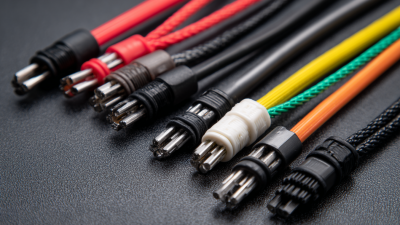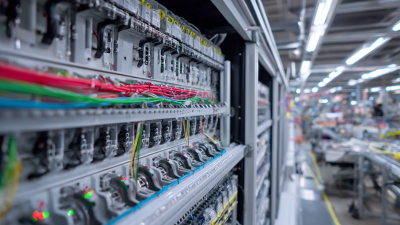In the fast-evolving world of manufacturing, mastering cable fabrication techniques is crucial for producing high-quality products that meet industry standards and consumer expectations. This guide delves into the essential aspects of cable fabrication, offering insights into the processes, tools, and skills necessary to excel in this field. Whether you are a novice looking to understand the basics or an experienced professional seeking to refine your skills, the techniques discussed here will empower you to create superior cables that enhance performance and reliability. From understanding different types of cables to exploring innovative fabrication methods, this ultimate guide will provide you with the knowledge and confidence to navigate the complexities of cable fabrication with ease. Join us as we embark on a journey to unlock the secrets behind successful cable manufacturing.

 Cable fabrication techniques play a pivotal role in determining the overall quality of industrial products. According to a report from MarketsandMarkets, the global cable manufacturing market is expected to reach $290 billion by 2025, underlining the increasing importance of these techniques in enhancing product performance and durability. Precision in cable fabrication is critical as it directly impacts the electrical and mechanical properties of the final product. A recent survey conducted by the International Electrotechnical Commission revealed that 60% of product failures in electrical applications can be traced back to inadequate cable fabrication processes.
Cable fabrication techniques play a pivotal role in determining the overall quality of industrial products. According to a report from MarketsandMarkets, the global cable manufacturing market is expected to reach $290 billion by 2025, underlining the increasing importance of these techniques in enhancing product performance and durability. Precision in cable fabrication is critical as it directly impacts the electrical and mechanical properties of the final product. A recent survey conducted by the International Electrotechnical Commission revealed that 60% of product failures in electrical applications can be traced back to inadequate cable fabrication processes.
Additionally, advanced cable fabrication techniques not only improve product reliability but also contribute to cost efficiency. A study by the International Wire & Cable Exhibitors Association highlighted that adopting automated fabrication techniques can reduce production costs by up to 20% while increasing output quality. By employing standardized fabrication methods, manufacturers can ensure consistency across their product lines, leading to higher customer satisfaction and reduced warranty claims. As the industry evolves, embracing sophisticated cable fabrication techniques will be essential for companies striving to maintain a competitive edge through superior product quality.
Cable fabrication is a crucial process in various industries, and understanding the different fabrication methods can significantly enhance product quality. Among the popular techniques, extrusion, braiding, and twisting stand out with their unique benefits. Extrusion allows for the creation of various cable jacket materials, providing flexibility and durability, which is essential in environments exposed to harsh conditions. Braiding adds an extra layer of strength and resistance to wear, making it ideal for applications requiring high tensile strength. Twisting, on the other hand, enables enhanced electrical performance and reduced electromagnetic interference, perfect for cables used in sensitive electronic equipment.
When exploring these methods, it’s important to consider specific tips to optimize results. Firstly, always select high-quality raw materials tailored to the desired end-use for better performance. Secondly, invest in proper machinery that suits your fabrication method; this can significantly reduce production time and improve consistency. Lastly, regularly maintain equipment to ensure precision and avoid costly downtimes that could impact your overall production efficiency. By mastering these fabrication techniques and adhering to best practices, you can achieve superior products that stand out in a competitive market.

Mastering cable fabrication techniques is crucial for manufacturers aiming to enhance efficiency and minimize waste. By adopting innovative methodologies, like lean manufacturing principles, companies can significantly reduce non-value added (NVA) activities in their production processes. This is particularly relevant in industries such as construction, where streamlining operations can lead to substantial improvements in cost and resource management. Implementing these optimized techniques in cable fabrication not only improves the quality of the final products but also contributes to a more sustainable manufacturing environment.
Moreover, advancements in digital and additive manufacturing have ushered in new possibilities for creating cable products. The integration of recycling initiatives and efficient material utilization fosters a circular economy, where waste is minimized, and resources are reused effectively. As businesses continue to embrace these cutting-edge technologies, the ability to produce superior products while promoting sustainability will become a determining factor in their competitiveness in the market. Therefore, mastering cable fabrication is not just about improving machinery or processes; it's about rethinking how to create value through innovation and responsible manufacturing practices.
Achieving superior products through advanced cable fabrication techniques is increasingly becoming a reality in various industries. The integration of innovative materials such as polymer composites, especially when coupled with cutting-edge 3D printing technologies, has transformed traditional manufacturing processes. A recent study indicates that the use of polymer composites in civil infrastructure can significantly enhance strength and durability while reducing weight by up to 30%. This advancement provides the foundation for creating cables that are not only more resilient but also tailored for specific applications.
In addition to mechanical enhancements, advanced cable fabrication techniques now employ hybrid architectures that leverage artificial intelligence for real-time predictions in engineering systems. Research has shown that combining LSTM and transformer models can improve task efficiency by up to 40%, allowing manufacturers to optimize production lines and reduce costs. This convergence of technology signifies a shift towards smarter manufacturing processes, wherein real-world applications can be seen in industries ranging from telecommunications to automotive, where superior cable products are paramount to performance and reliability.
Choosing the right cable fabrication technique is crucial for ensuring the quality and performance of the final product. According to a report by Allied Market Research, the global cable manufacturing market is projected to reach $305 billion by 2026, driven by the increasing demand for sophisticated electrical systems and telecommunications. This surge emphasizes the importance of selecting fabrication methods that not only meet industry standards but also align with specific project requirements.
When considering cable fabrication techniques, it's essential to assess factors such as material compatibility, production volume, and environmental conditions. For instance, extrusion is a popular method for mass production due to its efficiency and scalability, making it suitable for standard cables. Conversely, specialized applications may benefit from processes like braiding or twisting, which provide added strength and flexibility. A 2020 study in the Journal of Wire and Cable Technology noted that choosing the right technique could enhance product lifespan by up to 30%, particularly in high-stress environments. Therefore, understanding the unique demands of each project is vital in making informed decisions that contribute to superior cable products.
| Technique | Material | Applications | Advantages | Disadvantages |
|---|---|---|---|---|
| Cutting | Copper, Aluminum | Wiring, Electronics | High precision, Fast | Requires skilled labor |
| Crimping | Copper, Steel | Connectors, Terminals | Strong connections, Quick | Potential for connection failures |
| Soldering | Copper, Silver | Circuit boards, Components | Excellent conductivity, Versatile | Time-consuming, Skill required |
| Laser Cutting | Various Metals | Custom shapes, Sheet metal | High accuracy, Minimal waste | High setup cost, Limited materials |
| Assembly | Plastic, Metal | Final Products, Harnesses | Customization options, Completeness | Labor-intensive |






